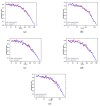Real-Time Prognostics of Engineered Systems under Time Varying External Conditions Based on the COX PHM and VARX Hybrid Approach
- PMID: 33801314
- PMCID: PMC7958339
- DOI: 10.3390/s21051712
Real-Time Prognostics of Engineered Systems under Time Varying External Conditions Based on the COX PHM and VARX Hybrid Approach
Abstract
In spite of the development of the Prognostics and Health Management (PHM) during past decades, the reliability prognostics of engineered systems under time-varying external conditions still remains a challenge in such a field. When considering the challenge mentioned above, a hybrid method for predicting the reliability index and the Remaining Useful Life (RUL) of engineered systems under time-varying external conditions is proposed in this paper. The proposed method is competent in reflecting the influence of time-varying external conditions on the degradation behaviour of engineered systems. Based on a subset of the Commercial Modular Aero-Propulsion System Simulation (C-MAPSS) dataset as case studies, the Cox Proportional Hazards Model (Cox PHM) with time-varying covariates is utilised to generate the reliability indices of individual turbofan units. Afterwards, a Vector Autoregressive model with Exogenous variables (VARX) combined with pairwise Conditional Granger Causality (CGC) tests for sensor selections is defined to model the time-varying influence of sensor signals on the reliability indices of different units that have been previously generated by the Cox PHM with time-varying covariates. During the reliability prediction, the Fourier Grey Model (FGM) is employed with the time series models for long-term forecasting of the external conditions. The results show that the method that is proposed in this paper is competent for the RUL prediction as compared with baseline approaches.
Keywords: Conditional Granger Causality (CGC); Cox proportional hazards model (PHM); Fourier Grey model (FGM); Vector Autoregressive model with exogenous variables (VARX); prognostics; time-varying covariates.
Conflict of interest statement
The authors declare no conflict of interest.
Figures













Similar articles
-
Remaining Useful Life Estimation Using Deep Convolutional Generative Adversarial Networks Based on an Autoencoder Scheme.Comput Intell Neurosci. 2020 Aug 1;2020:9601389. doi: 10.1155/2020/9601389. eCollection 2020. Comput Intell Neurosci. 2020. PMID: 32802032 Free PMC article.
-
Joint Learning of Failure Mode Recognition and Prognostics for Degradation Processes.IEEE Trans Autom Sci Eng. 2024 Apr;21(2):1421-1433. doi: 10.1109/tase.2023.3239004. Epub 2023 Jan 30. IEEE Trans Autom Sci Eng. 2024. PMID: 38595999 Free PMC article.
-
Remaining Useful Life Estimation of Aircraft Engines Using a Joint Deep Learning Model Based on TCNN and Transformer.Comput Intell Neurosci. 2021 Nov 24;2021:5185938. doi: 10.1155/2021/5185938. eCollection 2021. Comput Intell Neurosci. 2021. PMID: 34868292 Free PMC article.
-
Sensor systems for prognostics and health management.Sensors (Basel). 2010;10(6):5774-97. doi: 10.3390/s100605774. Epub 2010 Jun 8. Sensors (Basel). 2010. PMID: 22219686 Free PMC article. Review.
-
Challenges and Opportunities of System-Level Prognostics.Sensors (Basel). 2021 Nov 18;21(22):7655. doi: 10.3390/s21227655. Sensors (Basel). 2021. PMID: 34833731 Free PMC article. Review.
References
-
- Frankel E.G. Systems Reliability and Risk Analysis. 1st ed. Springer Science & Business Media; Dordrecht, The Netherlands: 1984. Basic Concepts of Reliability; pp. 15–16.
-
- Høyland A., Rausand M. System Reliability Theory: Models and Statistical Methods. 1st ed. John Wiley & Sons; Hoboken, NJ, USA: 1994. Basic Concepts; pp. 5–6.
-
- Javed K., Gouriveau R., Zerhouni N. State of the art and taxonomy of prognostics approaches, trends of prognostics applications and open issues towards maturity at different technology readiness levels. Mech. Syst. Signal Process. 2017;94:214–236. doi: 10.1016/j.ymssp.2017.01.050. - DOI
-
- ISO . Condition Monitoring and Diagnostics of Machines—Prognostics. ISO; Geneva, Switzerland: 2015. BS ISO 13381-1:2015.
-
- Sankararaman S., Daigle M.J., Goebel K. Uncertainty quantification in remaining useful life prediction using first-order reliability methods. IEEE Trans. Reliab. 2014;63:603–619. doi: 10.1109/TR.2014.2313801. - DOI
LinkOut - more resources
Full Text Sources
Other Literature Sources
Miscellaneous

